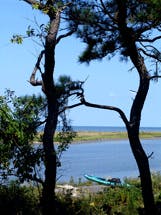Runoff from new development is polluting Chesapeake Bay faster than communities in Maryland and the rest of the region are acting to curb it, says a new report by the Environmental Protection Agency's Office of Inspector General that you can find here.
The report, released Wednesday, warns that restoration of the Cheapeake is jeopardized by the failure of all levels of government to keep nutrients and mud from washing off newly developed land. Though developed land generates less pollution than farm runoff and sewage treatment plants, correcting it could be very costly, the report adds.
The Inspector General, who audits EPA's performance, calls for the agency to push bay states and communities to adopt binding caps, or limits, on nutrient pollution from developed and developing lands. Curbing runoff could be achieved through stricter stormwater controls and through requiring more concentrated development with environmentally sensitive designs, the report says.
Stormwater runoff and seepage from septic waste-treatment systems account for about 24 percent of the nitrogen and 30 percent of the phosphorus fouling the bay, by EPA estimates. But because development continues to sprawl with relatively modest runoff controls across the six-state bay region, the amount of pollution is increasing. The amount of pavement covering the 64,000 square mile watershed increased by 41 percent during the 1990s, EPA estimates, while population grew by only 8 percent.
The report says that of eight communities it checked in the region, only the District had set hard goals for reducing urban runoff. And while EPA and the bay states have agreed to curb sprawl as a way of restoring the bay, officials can't even agree on how to define sprawl, so have done nothing to track it in a measurable way, the report adds.
The report also faults EPA and the bay states for not using their legal authority to regulate stormwater runoff. Maryland's General Assembly did adopt a new stormwater law this year, but the state Department of the Environment is still drafting regulations to carry it out. And while federal and state governments have oversight, enforcement of stormwater controls is left up to local governments.
Source: Baltimore Sun


